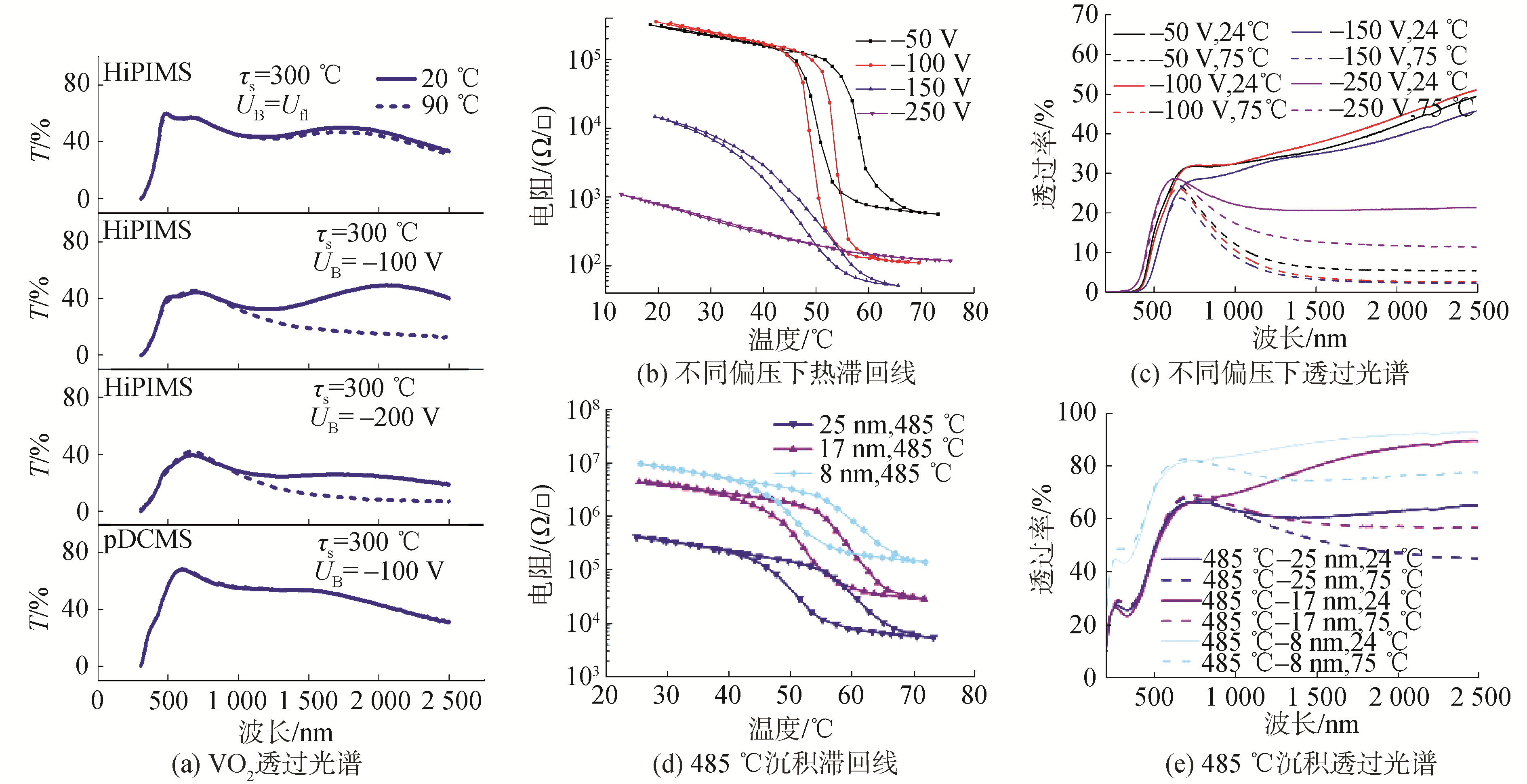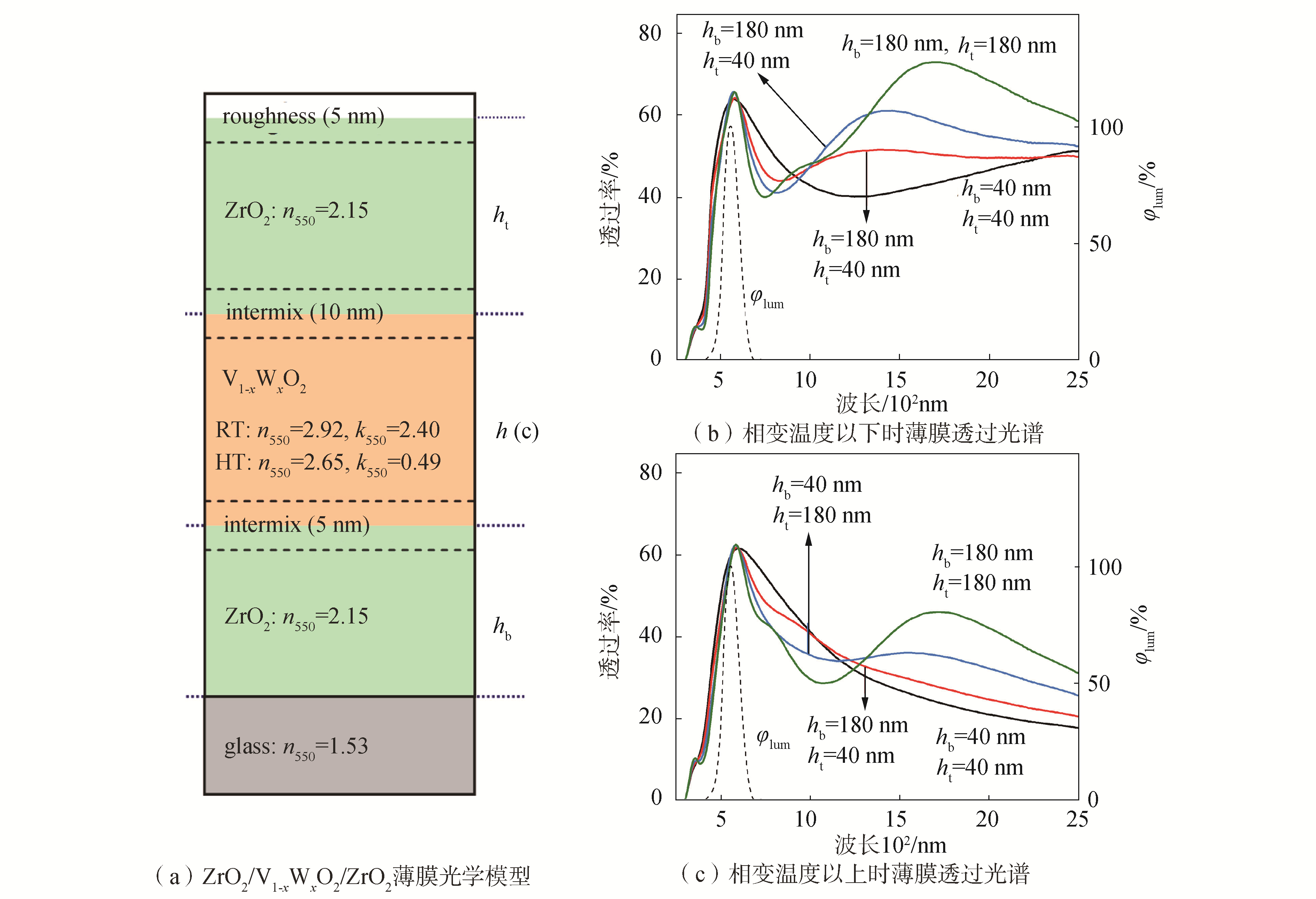2. 哈尔滨工业大学 复合材料与结构研究所, 黑龙江 哈尔滨 150001
2. Center for Composite Materials and Structure, Harbin Institute of Technology, Harbin 150001, China
高能脉冲磁控溅射(HiPIMS)技术是在直流磁控溅射技术(direet current magnerction sputtering,DCMS)基础上发展起来的一种新兴的电离化物理气相沉积技术(physical vapour deposition, PVD),区别于传统磁控溅射技术,HiPIMS技术具有峰值功率密度高(1 kW/cm2),靶附近平均离子密度大(107/cm2)的特点,所制得的薄膜平整致密,与基底结合良好,同时表现出优异的膜层性能[1-3]。目前,采用HiPIMS技术已经可以沉积得到大量功能材料薄膜,如TiO2[4]、ZrO2[5-6]、WC-DLC[7]、VO2[8]等。
二氧化钒(VO2)具有可逆的金属-绝缘体相变(MIT),是一种热致变色材料,相变前后其光学性能会发生显著变化,在近红外波段由低温的高透过转变为高温的高反射状态[10-12]。VO2相变温度在340 K左右,是最接近室温的热致变色材料之一,在智能窗、热控和辐射热测定器等领域具有广阔的应用潜力和空间[11-15]。传统磁控溅射技术如直流磁控溅射(DCMS)和射频磁控溅射(RFMS)技术如果溅射时基底温度满足要求,则可以直接溅射制备VO2薄膜,否则需要后退火等处理;而基底温度一般要控制在450 ℃以上,难以满足在柔性基底上的制备。而高能脉冲磁控溅射技术可以利用高能离子轰击降低薄膜的沉积温度,即在较低的制备温度下获得VO2薄膜,扩展了VO2薄膜的基底材料[8, 16]。此外,采用HiPIMS技术沉积的VO2薄膜表面致密,不仅能够降低其相变温度,还具有相对良好的环境稳定性[17]。
本文首先介绍高能脉冲磁控溅射技术(HiPIMS),其次阐述了HiPIMS技术制备VO2的最新研究进展,最后展望HiPIMS技术在VO2薄膜制备上的应用前景。
1 高能脉冲磁控溅射技术高能脉冲磁控溅射(HiPIMS)是一种新兴的物理气相沉积技术(physical vapour deposition, PVD)[18-19]。该技术主要工作原理如图 1(a)所示,HiPIMS技术在极高的脉冲电压作用下使氩气(Ar)高度电离,形成大量Ar+等离子体,极端情况下会产生高价等离子体(Ar2+),在舱内电磁场的作用下,正离子向阴极靶材高速移动,靶材溅射出来大量的金属离子,一部分金属离子在电场的作用下会继续向靶面撞击溅射出二次离子,该过程称为靶的自溅射过程[20-22],另一部分金属离子由于动能较高,摆脱电场的束缚,沉积到基片上成膜。与传统的磁控溅射相比,HiPIMS采用脉冲供电方式,频率为几十赫兹到千赫兹,脉冲宽度为10~500 μs,峰值功率极高,为平均功率的百倍以上,极大地提升了放电过程中的离化率。较低的占空比消除了由于电荷累积造成的“打火”现象,克服了传统磁控溅射功率过高时水冷不足引起的靶材过热难题,保证了设备运行的安全性和稳定性,实现了高功率磁控溅射薄膜制备。高能脉冲磁控溅射技术的电压-电流曲线如图 1(b)所示,随着电压的施加,靶电流逐渐增加,当电压消失时,电流急剧下降,但仍不为零。可以看出一个脉冲周期内,峰值功率达到几十千瓦。在较短的脉冲时间内,高能脉冲磁控放电过程如图 1(c)所示。阶段Ⅰ:电流随施加电压逐渐升高,在电压结束时出现峰值电流,由于电压很低,此时峰值电流很小。阶段Ⅱ:随着电压升高,峰值电流急剧增加,靶材溅射出的金属离子足够多,其中会有部分金属离子轰击靶材,提高了靶材的溅射效率,由于轰击靶材的离子是靶材自身溅射出的离子,所以将这种溅射称为自溅射。当电压消失时由气体放电所产生的电流也会消失,而自溅射产生的离子电流则会有一个短暂的滞后。阶段Ⅲ:电压继续增高后,峰值电流也迅速增加,对应于气体放电的剧烈变化。阶段Ⅳ:当电压增加到一定值时,在整个脉冲内电流随电压迅速变化,对应于自溅射的增强。阶段Ⅴ:当电压过高时则会处于一种不稳定放电的状态,靶材表面剧烈放电,甚至产生电弧。一般高能脉冲磁控溅设发射在阶段Ⅱ和Ⅳ,此时金属靶材的离化率高,放电特性稳定,所制备的膜结构光滑致密,与基底间结合力变强,机械性能得到明显提升,能满足结构性质复杂的化合物薄膜制备要求[3, 19-22]。

|
Download:
|
| 图 1 HiPIMS工作原理及放电过程特性曲线 Fig. 1 A schematic diagram for the working mechanism and the typical discharge process curve of HiPIMS | |
由于HiPIMS技术的诸多优点,在1999年由Kouznetsov V[24]提出该方法后发展迅速,近年来高能脉冲磁控溅射技术应用越来越广泛。有研究发现将高能脉冲磁控溅射技术应用于制备VO2薄膜,所获得的VO2薄膜较其他方法更加平滑致密,耐久性和抗氧化性有明显提升[1, 9],在一定条件下可大幅降低其制备温度[24-26],为VO2薄膜制备提供了新的选择。
2 高能脉冲磁控溅射制备VO2薄膜 2.1 VO2薄膜热致变色机理二氧化钒(VO2)是一种多晶相过渡金属氧化物,只有单斜相VO2(M)和金红石相VO2(R)之间才能发生可逆一级相变[27-28]。图 2(a)、(b)为VO2低温单斜相(M)和高温金红石相(R)的结构,VO2相变前后的变化使自身的电学和光学性质也发生显著地变化。当温度低于68 ℃时,单斜相VO2呈现半导体态,电阻较高,近红外波段高透过;当温度超过68 ℃时,转变为金红石相VO2,呈现金属态,电阻较低,近红外波段高反射。

|
Download:
|
| 图 2 VO2的相结构和电子能带结构图[28, 34] Fig. 2 Structures and electronic band structure of different VO2 phases [28, 34] | |
由于VO2相变的独特性,其具体的相变机理也受到了广泛的研究。目前有3种相变模型解释其相变机理,分别为莫特相变模型、佩尔斯相变模型和莫特-佩尔斯(Mott-Peierls)相变模型。莫特相变认为电子之间的交互作用驱动相变;佩尔斯相变则认为是晶格畸变驱动相变[29]。但是这2种理论都不能完美的解释VO2的相变机理,所以有学者提出第3种理论即莫特-佩尔斯相变模型,该模型认为结构变化和电子变化在VO2相变过程中具有协同作用[30-32]。
Goodenough基于电子能带理论对VO2的整体能带结构做出描述,并解释其导电的原因[33]。如图 2(c)、(d)所示,金红石相时π*能带与d//能带之间的重叠部分恰好处于费米能级之上,电子可以跃迁,所以能够表现出金属导电的特性;单斜相时d//分离为d//和d//*2个轨道,而在d//能带和π*能带之间形成一个带宽约为0.7 eV的禁带,费米能级恰好处于禁带之间,电子难以跃迁,使VO2表现出绝缘性。
2.2 HiPIMS技术制备VO2薄膜研究由于钒(V)价态多样,其氧化物种类繁多,制备具有热致变色特性VO2薄膜的条件极为苛刻。VO2薄膜物理性质受自身晶体结构和形貌所决定,而薄膜的晶体结构和形貌显然又与沉积过程中工艺参数有关[34]。对于HiPIMS技术而言,氩氧比、溅射功率、基片偏压和沉积温度等参数都会对VO2薄膜的性能产生影响。目前对于HiPIMS技术沉积的VO2薄膜的研究主要集中于降低VO2沉积温度和优化工艺参数得到结晶良好VO2薄膜[35-36]。
高能脉冲磁控溅射的高能溅射离子可以促进薄膜生长,因此该方法也能降低VO2的制备温度。Martinu等[1]采用高能脉冲磁控溅射技术在300 ℃基底温度下沉积得到致密的VO2薄膜,如图 3(a)、(b)所示,薄膜结晶良好,在2 500 nm处相变后透过率(T2500)变化61%,同时相变温度降低至50 ℃。此外,该课题组利用HiPIMS技术在聚酰亚胺柔性聚合物基底上沉积热致变色VO2薄膜,其制备温度可以降低至300 ℃以下,很大程度解决柔性基底材料受温度限制的问题,但是薄膜的热致变色性能也因此受到影响,相变程度比较小,其中相转变温度在68 ℃左右,而且热滞回线的宽度也比较大[8]。此外,AIJAZ等[26]通过施加偏压增加衬底附近的等离子密度来提高电流通量,促进VO2薄膜在低温下的生长,制备温度也可以降低到300 ℃,但薄膜室温透过率较低,如图 4(a)所示。王浪平等[37]则证明了基底偏压会影响VO2薄膜晶体取以及晶体尺寸,进而影响薄膜相变性能。如图 4(b)、(c)所示,当偏压从-50 V增加到-250 V时,薄膜晶粒尺寸逐渐变小,同时相变温度从54 ℃降至31.5 ℃,热滞回线宽度也逐渐变窄,施加-150 V偏压所制备的VO2薄膜相变前后ΔT2500变化较大。该课题组研究人员又利用HiPIMS技术在石英玻璃上沉积了不同厚度的VO2薄膜,研究了厚度对VO2薄膜热致变色特性的影响。如图 4(d)、(e),VO2薄膜厚度影响了薄膜的相变温度,厚度的增加使薄膜的相变温度下降,在衬底温度485 ℃时获得的8 nm超薄VO2薄膜可见透过达到75%以上[38]。

|
Download:
|
| 图 3 利用HiPIMS技术沉积的75nmVO2薄膜的结晶性及光学性能[1] Fig. 3 Crystallinity and optical properties of a 75 nm thick VO2 film deposited by HiPIMS[1] | |

|
Download:
|
| 图 4 VO2透过光谱及热滞回线图 Fig. 4 Spectral transmittance and temperature dependence of sheet resistance of the VO2 thin films | |
此外,相关研究表明高能脉冲磁控溅射技术获得的致密VO2薄膜能显著提高其环境稳定性。Loquai S等[17]研究了HiPIMS和RFMS技术制备的VO2薄膜环境稳定性,与RFMS技术相比,利用HiPIMS技术制备的薄膜更加致密,在80 ℃和相对湿度100%的条件老化52 h后仍然保持相对较低粗糙度,ΔT2500从56.4%下降到46.7%,而普通射频磁控溅射制备得到的薄膜经过相同条件老化之后,ΔT2500从55.2%下降到9%,如图 5所示。结果表明高能脉冲磁控溅射技术获得的VO2薄膜具有相对较高的环境稳定性。

|
Download:
|
| 图 5 利用RFMS和HiPIMS技术制备的VO2薄膜老化前后透过光谱 Fig. 5 Transmittance spectra of pre- and post-aging VO2 films prepared by RFMS and HiPIMS[17] | |
在基底上和VO2薄膜之间引入与VO2结构相似的缓冲层可以提高VO2薄膜热致相变性能。此外,利用光的干涉原理引入一定厚度的增透层,如TiO2[39-41]、ZrO2[42]、Cr2O3[43]等,设计制备多层膜可以提高VO2薄膜的光学性能。目前采用高能脉冲磁控溅射技术制备VO2多层膜的研究开始有文献报道[42-44]。
为防止高温时钠钙玻璃中钠的扩散影响薄膜的结晶性,Juan Pichun等[42]设计了VO2/TiO2/glass结构,发现TiO2层不仅可作为缓冲层缓解碱金属的扩散,还可以改善薄膜的光学性能。如图 6(a)、(b)所示,将制备得到的VO2/TiO2双层膜用于热致变色智能窗,其对太阳辐射的调节能力可以达到10.4%。玻璃衬底通常呈现非晶结构,所以沉积在玻璃衬底上的薄膜一般具有多晶结构,热致相变性能较差[40, 43]。Kang Chaoyang等[42]选择ZrxOy作为VO2薄膜生长的结构模板,设计并制备了VO2/ZrxOy/glass双层膜,研究了不同温度下制备的ZrxOy缓冲层对VO2薄膜性能的影响如图 6(c)~(i)所示。在图 6(d~i)中可以观察到,当缓冲层的生长温度达到550 ℃时,形成的ZrO2单斜相结构会显著改善M-VO2薄膜的结晶性,降低了热滞回线宽度。

|
Download:
|
| 图 6 不同结构的VO2多层膜性能示意 Fig. 6 Schematic diagram of VO2 multilayer film performance of different structures | |
Jiri Houska等[43]设计了ZrO2/V1-xWxO2/ZrO2结构,利用二阶干涉效应来改善薄膜光学性能。图 7(a)为所设计的三层膜结构示意图,选用ZrO2作为增透层,W掺杂降低VO2薄膜相变温度;如图 7(b)、(c)所示实验得到的ZrO2(180 nm)/V0.988W0.012O2(70 nm)/ZrO2(180 nm)薄膜可见光透过比可达到57.2%,所制备ZrO2(180 nm)/V0.988W0.012O2(70 nm)/ZrO2(205 nm)薄膜的相变温度降低到40 ℃。此外,该组研究人员还选用SiO2作为顶层增透层设计了VO2/SiO2双层结构,SiO2薄膜的引入可将室温下可见光透过比Tlum提高16%,同时提升太阳辐射调节能力,从7.7%提高到了10.3%[44]。

|
Download:
|
| 图 7 ZrO2/V1-xWxO2/ZrO2薄膜光学模型及透过光谱[45] Fig. 7 Optical model and transmittance spectra of ZrO2/V1-xWxO2/ZrO2 films[45] | |
HiPIMS技术具有高峰值功率密度、高电离度和高等离子体密度等特点,是磁控溅射发展的重要方向,在大规模生产和使用中也具有潜在应用价值。基于上述优点,HiPIMS技术被广泛的应用于沉积VO2薄膜,通过调控高能脉冲磁控溅射的沉积参数,控制溅射出来的金属靶粒子能量,实现低温原位制备VO2薄膜。HiPIMS技术的放电特性受到沉积气体和靶材的影响。在采用高能脉冲磁控溅射的过程中氩氧比、溅射功率、基片偏压和沉积温度等参数都会对VO2薄膜的性能产生影响。目前HiPIMS技术沉积的VO2薄膜的研究主要集中于降低VO2沉积温度和优化工艺参数得到结晶良好VO2薄膜,进而获得柔性VO2薄膜和提高薄膜的环境稳定性。但是在利用HiPIMS技术制备VO2的过程中仍需面临许多挑战,现总结如下两点:
1) 在应用HiPIMS技术沉积VO2薄膜的过程中,靶表面以及仓体里的状况对沉积过程具有显著的影响,研究如何避免因靶材中毒产生电弧放电现象以及高峰值离子电流引起的基底偏置,将对沉积薄膜的质量提高具有重要意义。
2) 与传统磁控溅射技术制备VO2薄膜相比,HiPIMS技术溅射过程中成膜机理尚未厘清,缺乏制备参数对成膜性能影响规律的详细研究,仍需要开展大量研究工作。
综上所述,未来对HiPIMS技术制备VO2薄膜的固有溅射机制、电弧现象以及相对复杂的工艺技术等进行更加深入的研究,将有利于推进VO2薄膜在智能窗、智能热控、微辐射计和微机械等领域的应用。
| [1] |
FORTIER J P, BALOUKAS B, ZABEIDA O, et al. Thermochromic VO2 thin films deposited by HiPIMS[J]. Solar energy materials and solar cells, 2014, 125: 291-296. (  0) 0)
|
| [2] |
左潇, 孙丽丽, 汪爱英, 等. 高功率脉冲磁控溅射制备非晶碳薄膜研究进展[J]. 表面技术, 2019, 48(9): 53-63. ZUO Xiao, SUN Lili, WANG Aiying, et al. Research progress on preparation of amorphous carbon thin films by high power impulse magnetron sputtering[J]. Surface technology, 2019, 48(9): 53-63. (  0) 0)
|
| [3] |
李春伟, 田修波, 宋炜昱, 等. 工作参数对磁场增强高功率脉冲磁控溅射放电特性的影响[J]. 真空科学与技术学报, 2018, 38(4): 264-271. LI Chunwei, TIAN Xiubo, SONG Weiyu, et al. Effect of synthesis conditions on discharge behavior of magnetic field enhanced high power impulse magnetron sputtering[J]. Chinese journal of vacuum science and technology, 2018, 38(4): 264-271. (  0) 0)
|
| [4] |
OLEJNÍČEK J, HUBIČKA Z, KMENT Š, et al. Investigation of reactive HiPIMS+MF sputtering of TiO2 crystalline thin films[J]. Surface and coatings technology, 2013, 232: 376-383. (  0) 0)
|
| [5] |
ZHAO Xiaoli, JIN Jie, CHENG J C, et al. Structural and optical properties of zirconia thin films deposited by reactive high-power impulse magnetron sputtering[J]. Thin solid films, 2014, 570: 404-411. (  0) 0)
|
| [6] |
ZUBKINS M, ARSLAN H, BIKSE L, et al. High power impulse magnetron sputtering of Zn/Al target in an Ar and Ar/O2 atmosphere:the study of sputtering process and AZO films[J]. Surface and coatings technology, 2019, 369: 156-164. (  0) 0)
|
| [7] |
WANG Lei, JIN Jie, ZHU Chengke, et al. Effects of HiPIMS pulse-length on plasma discharge and on the properties of WC-DLC coatings[J]. Applied surface science, 2019, 487: 526-538. (  0) 0)
|
| [8] |
LOQUAI S, BALOUKAS B, ZABEIDA O, et al. HiPIMS-deposited thermochromic VO2 films on polymeric substrates[J]. Solar energy materials and solar cells, 2016, 155: 60-69. (  0) 0)
|
| [9] |
KOLENATY D, HOUSKA J, VLCEK J. Improved performance of thermochromic VO2/SiO2 coatings prepared by low-temperature pulsed reactive magnetron sputtering:prediction and experimental verification[J]. Journal of alloys and compounds, 2018, 767: 46-51. (  0) 0)
|
| [10] |
MORIN F J. Oxides which show a metal-to-insulator transition at the Neel temperature[J]. Physical review letters, 1959, 3(1): 34-36. (  0) 0)
|
| [11] |
DOU Shuliang, ZHANG Weiyan, WANG Yuemin, et al. A facile method for the preparation of w-doped VO2 films with lowered phase transition temperature, narrowed hysteresis loops and excellent cycle stability[J]. Materials chemistry and physics, 2018, 215: 91-98. (  0) 0)
|
| [12] |
DOU Shuliang, WANG Yi, ZHANG Xiang, et al. Facile preparation of double-sided VO2 (M) films with micro-structure and enhanced thermochromic performances[J]. Solar energy materials and solar cells, 2017, 160: 164-173. (  0) 0)
|
| [13] |
DOU Shuliang, ZHANG Weiyan, WANG Yuemin, et al. The influence of temperature on preparing tungsten doped vanadium dioxide films by sol-gel method[J]. Materials research express, 2018, 6(1): 016408. (  0) 0)
|
| [14] |
CAVALLERI A, TÓTh C, SIDERS C W, et al. Femtosecond structural dynamics in VO2 during an ultrafast solid-solid phase transition[J]. Physical review letters, 2001, 87(23): 237401. (  0) 0)
|
| [15] |
SUN Kai, RIEDEL C A, URBANI A, et al. VO2 thermochromic metamaterial-based smart optical solar reflector[J]. ACS photonics, 2018, 5(6): 2280-2286. (  0) 0)
|
| [16] |
SARAKINOS K, ALAMI J, KONSTANTINIDIS S. High power pulsed magnetron sputtering:a review on scientific and engineering state of the art[J]. Surface and coatings technology, 2010, 204(11): 1661-1684. (  0) 0)
|
| [17] |
LOQUAI S, BALOUKAS B, KLEMBERG-SAPIEHA J E, et al. HiPIMS-deposited thermochromic VO2 films with high environmental stability[J]. Solar energy materials and solar cells, 2017, 160: 217-224. (  0) 0)
|
| [18] |
ZHANG Haibao, CHERNG J S, CHEN Qiang. Recent progress on high power impulse magnetron sputtering (HiPIMS):the challenges and applications in fabricating VO2 thin film[J]. AIP advances, 2019, 9(3): 035242. (  0) 0)
|
| [19] |
LUNDIN D, SARAKINOS K. An introduction to thin film processing using high-power impulse magnetron sputtering[J]. Journal of materials research, 2012, 27(5): 780-792. (  0) 0)
|
| [20] |
EHIASARIAN A P. High-power impulse magnetron sputtering and its applications[J]. Pure and applied chemistry, 2010, 82(6): 1247-1258. (  0) 0)
|
| [21] |
艾猛, 李刘合, 韩明月, 等. 高功率脉冲磁控溅射等离子体放电特性研究现状[J]. 表面技术, 2018, 47(9): 176-186. AI Meng, LI Liuhe, HAN Mingyue, et al. Discharge characteristics of plasma made by high power pulse magnetron sputtering[J]. Surface technology, 2018, 47(9): 176-186. (  0) 0)
|
| [22] |
BRÄUER G, SZYSZKA B, VERGÖHL M, et al. Magnetron sputtering-milestones of 30 years[J]. Vacuum, 2010, 84(12): 1354-1359. (  0) 0)
|
| [23] |
KOUZNETSOV V, MACÁK K, SCHNEIDER J M, et al. A novel pulsed magnetron sputter technique utilizing very high target power densities[J]. Surface and coatings technology, 1999, 122(2/3): 290-293. (  0) 0)
|
| [24] |
BARKER P M, KONSTANTINIDIS S, LEWIN E, et al. An investigation of c-HiPIMS discharges during titanium deposition[J]. Surface and coatings technology, 2014, 258: 631-638. (  0) 0)
|
| [25] |
LIN Tiegui, WANG Langping, WANG Xiaofeng, et al. Influence of bias voltage on microstructure and phase transition properties of VO2 thin film synthesized by HiPIMS[J]. Surface and coatings technology, 2016, 305: 110-115. (  0) 0)
|
| [26] |
AIJAZ A, JI Yuxia, MONTERO J, et al. Low-temperature synthesis of thermochromic vanadium dioxide thin films by reactive high power impulse magnetron sputtering[J]. Solar energy materials and solar cells, 2016, 149: 137-144. (  0) 0)
|
| [27] |
YUAN Xun, ZHANG Yubo, ABTEW T A, et al. VO2:orbital competition, magnetism, and phase stability[J]. Physical review B, 2012, 86(23): 235103. (  0) 0)
|
| [28] |
GAO Yanfeng, LUO Hongjie, ZHANG Zongtao, et al. Nanoceramic VO2 thermochromic smart glass:a review on progress in solution processing[J]. Nano energy, 2012, 1(2): 221-246. (  0) 0)
|
| [29] |
罗明海, 徐马记, 黄其伟, 等. VO2金属-绝缘体相变机理的研究进展[J]. 物理学报, 2016, 65(4): 047201. LUO Minghai, XU Maji, HUANG Qiwei, et al. Research progress of metal-insulator phase transition mechanism in VO2[J]. Acta physica sinica, 2016, 65(4): 047201. (  0) 0)
|
| [30] |
豆书亮.溶胶-凝胶法制备二氧化钒薄膜及其光谱性能研究[D].哈尔滨: 哈尔滨工业大学, 2014. DOU Shuliang, Preparation and optical performance of vanadium dioxide by sol-gel method[D]. Harbin: Harbin Institute of Technology, 2014. (  0) 0)
|
| [31] |
KIM H T, LEE Y W, KIM B J, et al. Monoclinic and correlated metal phase in VO2 as evidence of the Mott transition:coherent phonon analysis[J]. Physical review letters, 2006, 97(26): 266401. (  0) 0)
|
| [32] |
KIM S, KIM K, KANG C J, et al. Correlation assisted phonon softenings and the mott-peierls transition in VO2[J]. arXiv: 1207.1770, 2012.
(  0) 0)
|
| [33] |
AETUKURI N B, GRAY A X, DROUARD M, et al. Control of the metal-insulator transition in vanadium dioxide by modifying orbital occupancy[J]. Nature physics, 2013, 9(10): 661-666. (  0) 0)
|
| [34] |
林铁贵. VO2薄膜的HiPIMS制备工艺与相变温度调控机理研究[D].哈尔滨: 哈尔滨工业大学, 2017. LIN Tiegui. Study on HIPIMS preparation technology and phase transition temperature adjusting mechanism of VO2 film[D]. Harbin: Harbin Institute of Technology, 2017. (  0) 0)
|
| [35] |
VLČEK J, KOLENATÝ D, HOUŠKA J, et al. Controlled reactive HiPIMS-effective technique for low-temperature (300℃) synthesis of VO2 films with semiconductor-to-metal transition[J]. Journal of physics D:applied physics, 2017, 50(38): 38LT01. (  0) 0)
|
| [36] |
HOUŠKA J, KOLENATÝ D, REZEK J, et al. Characterization of thermochromic VO2 (prepared at 250℃) in a wide temperature range by spectroscopic ellipsometry[J]. Applied surface science, 2017, 421: 529-534. (  0) 0)
|
| [37] |
LIN Tiegui, WANG Langping, WANG Xiaofeng, et al. Influence of bias voltage on microstructure and phase transition properties of VO2 thin film synthesized by HiPIMS[J]. Surface and coatings technology, 2016, 305: 110-115. (  0) 0)
|
| [38] |
LIN Tiegui, ZHANG Yufen, ZHENG Decong. The ultrathin VO2(M) film with ultrahigh visible transmittance synthesized on the quartz glass substrate by HiPIMS[J]. Vacuum, 2018, 156: 449-455. (  0) 0)
|
| [39] |
MURAOKA Y, HIROI Z. Metal-insulator transition of VO2 thin films grown on TiO2(001) and (110) substrates[J]. Applied physics letters, 2002, 80(4): 583-585. (  0) 0)
|
| [40] |
MLYUKA N R, NIKLASSON G A, GRANQVIST C G. Thermochromic multilayer films of VO2 and TiO2 with enhanced transmittance[J]. Solar energy materials and solar cells, 2009, 93(9): 1685-1687. (  0) 0)
|
| [41] |
JUAN Pichun, LIN K C, LIN CHENGLI, et al. Low thermal budget annealing for thermochromic VO2 thin films prepared by high power impulse magnetron sputtering[J]. Thin solid films, 2019, 687: 137443. (  0) 0)
|
| [42] |
ZONG Haitao, GENG Chenchen, ZHANG Cong, et al. Tuning the electrical and optical properties of ZrxOy/VO2 thin films by controlling the stoichiometry of ZrxOy buffer layer[J]. Applied surface science, 2019, 487: 138-145. (  0) 0)
|
| [43] |
CHANG Tianci, CAO Xun, DEDON L R, et al. Optical design and stability study for ultrahigh-performance and long-lived vanadium dioxide-based thermochromic coatings[J]. Nano energy, 2018, 44: 256-264. (  0) 0)
|
| [44] |
HOUSKA J, KOLENATY D, VLCEK J, et al. Significant improvement of the performance of ZrO2/V1-xWxO2/ZrO2 thermochromic coatings by utilizing a second-order interference[J]. Solar energy materials and solar cells, 2019, 191: 365-371. (  0) 0)
|
 2020, Vol. 41
2020, Vol. 41


